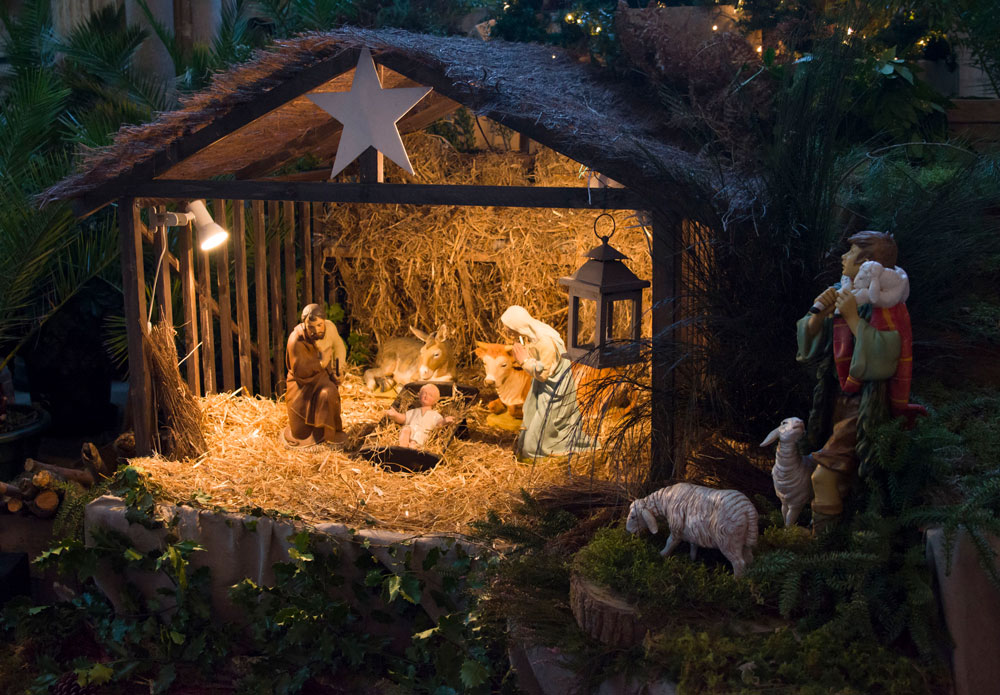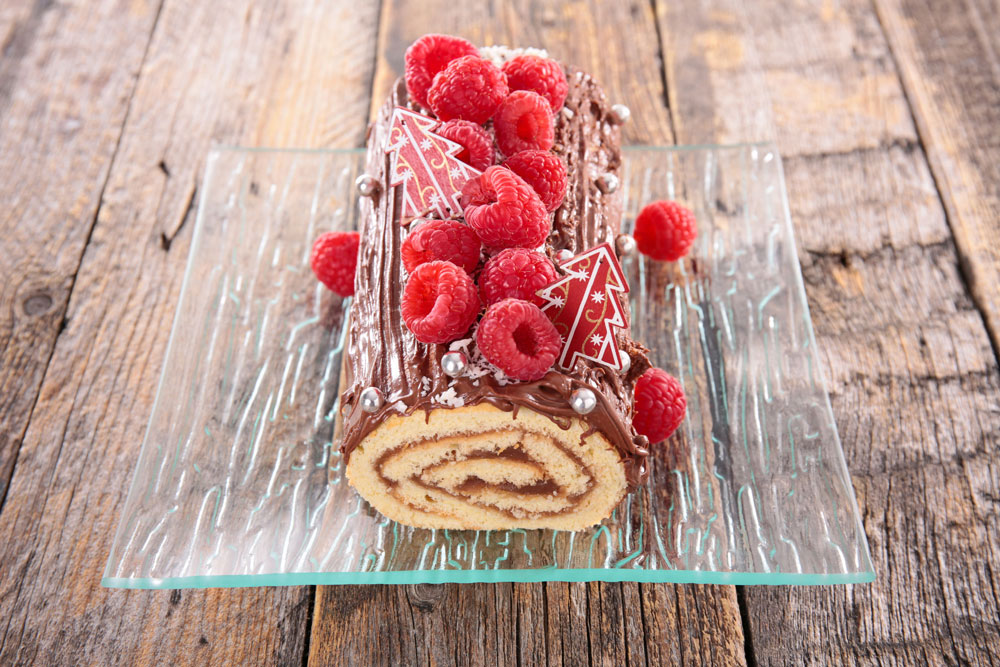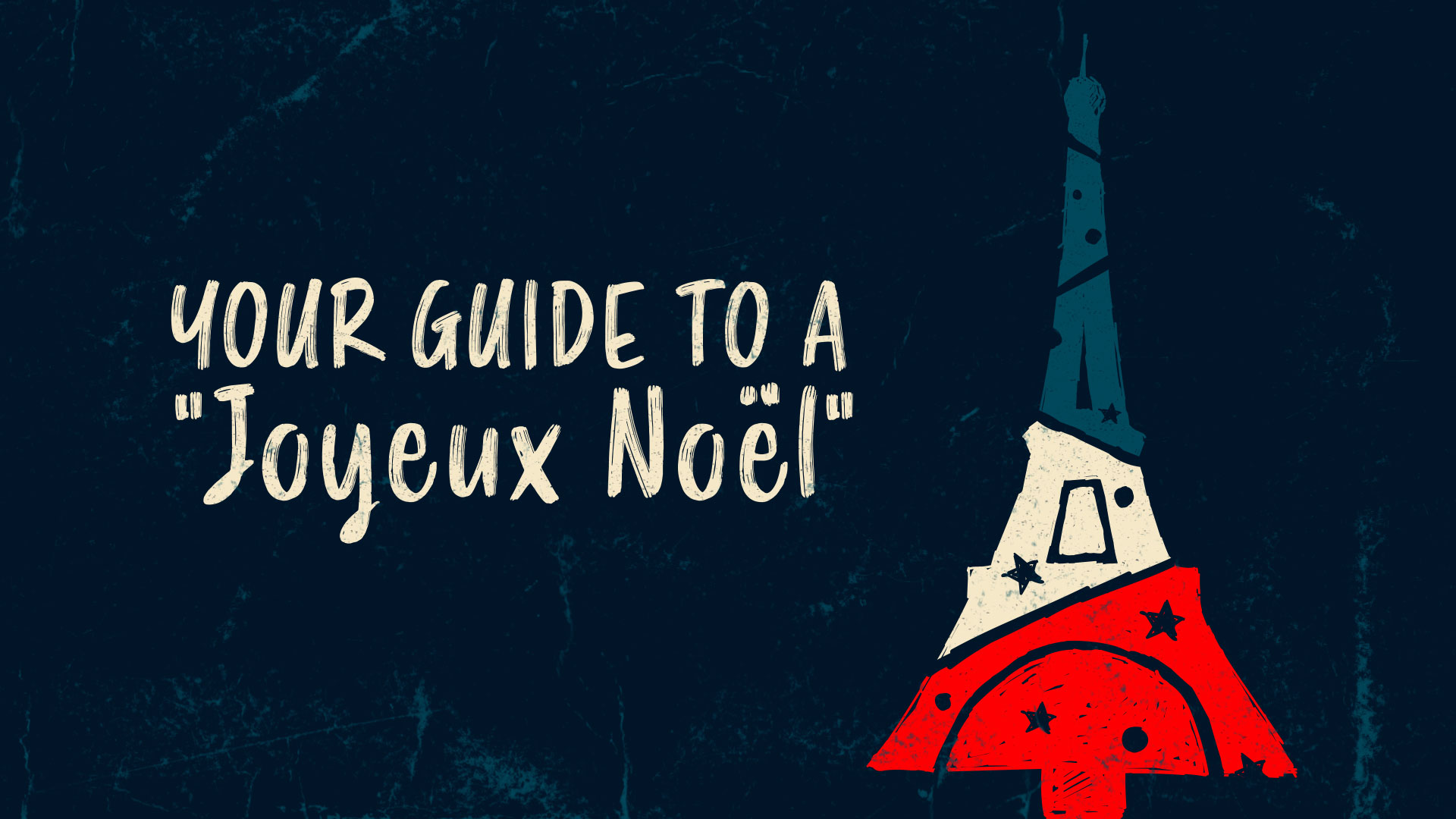“Merry Christmas” in French – How to Have a “Joyeux Noël” [In-Depth Guide]
Wondering how to say “Merry Christmas” in French? Here’s the quick answer: it’s Joyeux Noël!
Not enough for you? I agree!
Twinkling lights, jolly songs, and delicious food: the end-of-year holidays are upon us! If you’re here, there’s a good chance that you’re a Christmas fan.
Well, me too! And I’m also French, so I can tell you all about how to celebrate the merriest Christmas in French!
Before we start, a question for those of you who have a sweet tooth: have you ever dreamt of baking the perfect French bûche de Noël (“Yule log”)? Then stick around until the end because I’ve included a sweet bonus for you!
Ready? Allons-y! (“Let’s go!”)
Table of contents
- How to Say “Christmas” in French: Noël
- How to Say “Merry Christmas” in French: Joyeux Noël
- How to Say “Have a Merry Christmas” in French: Passe un Joyeux Noël
- How to Say “I Wish You a Merry Christmas” in French: Je Te Souhaite un Joyeux Noël
- How to Say “Merry Christmas Eve” in French
- How to Say “Merry Christmas and Happy New Year” in French: Joyeux Noël et Bonne Année
- How to Say “Happy Holidays” in French: Bonnes Fêtes
- Some French Christmas Traditions – Let’s Pick Up Christmas Vocabulary in French
- La Crèche de Noël – The Nativity Scene
- Le Sapin de Noël – The Christmas Tree
- Les Souliers de Noël – The Christmas Shoes
- Le Père Fouettard – The… Whipping Father?
- S’Embrasser Sous le Gui – To Kiss Under the Mistletoe
- Le Réveillon de Noël – The Christmas Dinner
- Les Oranges de Noël – Christmas Oranges
- La Bûche de Noël – The Yule Log
- Passez un Joyeux Noël!
How to Say “Christmas” in French: Noël
“Christmas” in French is Noël.
Noël comes from the Latin word natalis (“birth”). As you’ve probably guessed, it refers to the birth of Christ. Its first recorded use to describe Christmas comes from the 12th century.
Noël is perhaps the most famous fête de fin d’année (“end of year holiday”). It happens en Décembre (“in December”) and, in France and all countries in the northern hemisphere, en hiver (“in winter”).
Native tip: if you’re going to write the word down, don’t forget the tréma (“umlaut”). These two points above the e are important for the pronunciation of the word. Otherwise, it would sound like nél.
How to Say “Merry Christmas” in French: Joyeux Noël

If “Christmas” is Noël, how do you say “Merry Christmas” in French? The answer is: Joyeux Noël! Joyeux is the masculine version of the adjective for “happy” or “merry” in French.
Are you worried about the pronunciation? Remember that the French stress the last syllable of each word: Joyeux Noël.
How to Say “Have a Merry Christmas” in French: Passe un Joyeux Noël
Joyeux Noël is a good greeting to use in general, but there are other ways to wish a Merry Christmas. Especially to someone you won’t spend the holiday with.
Passe un joyeux Noël (“have a Merry Christmas”, literally “spend a Merry Christmas”) is perhaps the most popular among greetings for people you won’t see before after Christmas.
Native tip: Don’t forget that there are several ways to say “you” in French. Passe un joyeux Noël addresses the informal and singular “you”.
For the plural “you” or the formal singular vous, use passez un joyeux Noël.
How to Say “Have a Very Merry Christmas” in French: Passe un Très Joyeux Noël
Go the extra mile and wish your friends “have a very Merry Christmas”. Add très to the phrase you learnt above and you’re done! The result is passe/passez un très joyeux Noël.
How to Say “I Wish You a Merry Christmas” in French: Je Te Souhaite un Joyeux Noël
Souhaiter in French means “to wish”. To tell someone that you wish them a Merry Christmas, say je te/vous souhaite un joyeux Noël.
You might often hear the phrase on te/vous souhaite un joyeux Noel or nous te/vous souhaitons un joyeux Noël. They both mean “we wish you a Merry Christmas”.
How to Say “Merry Christmas Eve” in French
In France, la veille de Noël (“Christmas Eve”) is a big thing. I’ll tell you more about it below. For now, let’s focus on the words.
In French, “eve” is veille. La means “the” and de is “of”. If we were to translate the expression literally, we would get “the Eve of Christmas”.
You might also hear about la veillée de Noël. Don’t confuse the two!
Veillée means vigil. In the Christian religion, the veillée de Noël is a period of religious contemplation that comes right before the midnight Christmas Mass.
One more thing about Christmas Eve. French people often talk about le réveillon (de Noël), and you might think they are referring to Christmas Eve. Actually, the réveillon is the dinner held quite late on Christmas or New Year’s Eve. It is part of the eve, but it’s not the Eve itself. Still, it is frequent to use it as a replacement in the case of greetings.
There isn’t really a way to wish a Merry Christmas Eve in French. You could say passe un bon réveillon, but greetings about Christmas itself are much more common.
How to Say “Merry Christmas and Happy New Year” in French: Joyeux Noël et Bonne Année
We’ve just talked about wishing a Merry Christmas to the people you won’t spend the holiday with. If you’re talking to colleagues you won’t see before the new year, you might want to throw in a little something about that too.
“Merry Christmas and Happy New Year” is joyeux Noël et bonne année in French. The phrase literally translates to “Merry Christmas and good year”.
If you want to talk about “New Year” in French, talk about le nouvel an. That only applies if you’re talking about the celebration or January 1st, though. To talk about the coming new year, the whole 360+ days, you should use la nouvelle année.
“New Year’s Eve” is la veille du nouvel an. There is a réveillon on this night, too.
When the clock strikes midnight on December 31st, French will shout Bonne Année! (“Happy New Year, literally “Good Year”)
How to Say “Happy Holidays” in French: Bonnes Fêtes
“Merry Christmas” and “Happy New Year” aren’t the only end-of-year greetings you should know in French. Not everyone celebrates these holidays.
The fêtes de fin d’année (“end of year holidays”) include Hanoucca (“Hanukkah”), Kwanzaa, le Solstice d'hiver (“Winter Solstice”), and more. As these celebrations usually honor the concepts of love, happiness, and life, it is important to make your wishes broad and inclusive.
Here is a list of greetings you can use in any situation to wish others a great holiday season.
Bonnes Fêtes (de Fin d'Année) – “Happy (End of Year) Holidays”
Bonnes fêtes in French is “happy holidays”. It is the shorter version of bonnes fêtes de fin d'année (literally “good end of year celebrations”).
Suitable for both formal and informal situations, it is commonly used in any type of communication during the holidays period. It is one of the most popular vocal greetings and you can sign your letters and emails with it!
Bonnes et Heureuses Fêtes – “Very Happy Holidays”
As you’ve probably guessed, this expression is a sibling of the ones we just talked about.
The literal translation of bonnes et heureuses fêtes is “good and happy holidays”. As it is quite a long phrase, it usually belongs in letters and holiday cards.
Joyeuses Fêtes – “Joyous Holidays”
You may recognize joyeuse from joyeux Noël. Joyeuse is the feminine version of the French adjective for “joyous” or “merry”.
Joyeuses fêtes is not exactly a modern greeting, so it is less popular than bonnes fêtes.
Meilleurs Vœux – “Best Wishes” or “Season’s Greetings”
Like in English, the expression meilleurs vœux (“best wishes”) is a great greeting to keep close by. You could use it in any kind of situation that calls for… well, good wishes. And not only during the end of the year holidays!
Native tip: Meilleurs vœux is not used in spoken French very often anymore. It tends to appear in written texts, such as holiday cards.
Other French Greetings for the Holidays
Want to play it fancy? Write vœux de bonheur (“wishes of happiness”) in your cards, letters, or texts. Add pour un joyeux Noël (“for a Merry Christmas”) or pour une bonne année (“for a good year”) to be even more distinguished.
If you want to highlight the fact that Christmas is a family thing, use passez un joyeux Noël en famille (“Have a Merry Christmas with your family”).
Be polite and elegant with je vous souhaite d’excellentes fêtes (“I wish you an excellent holiday season). The phrase is even more powerful if you follow it up with et bonne année! (“and Happy New Year!”)
Some French Christmas Traditions – Let’s Pick Up Christmas Vocabulary in French
French is the official language in 29 countries. As I come from France, I will tell you about some French Christmas traditions. Let me know in the comments if you know about Christmas traditions in other French-speaking countries!
La Crèche de Noël – The Nativity Scene

Christmas traditions are deeply rooted in French culture as Christmas is quite an important holiday in France. And since Christmas is a Christian holiday… Some of the traditions are related to the religion.
One of them is the tradition of having a crèche near the Christmas tree, or at least in the house. Religious families usually place it in the center of their home.
In today’s French, crèche is most often used as “nursery”. However the crèche is also the manger where the infant Jesus was placed after his birth in the stable. In a Christmas setting, la crèche is a miniature reconstruction of the original Christmas night as described in the Christian religion.
La Crèche de Noel usually features l’enfant Jésus (“infant Jesus”), Marie et Joseph (“Mary and “Joseph”), l’âne et le bœuf (“the donkey and the ox”), les bergers et leurs moutons (“the shepherds and their sheeps”), and les Rois Mages (“the Wise Men”). Some also have une étoile (“a star”) and des anges (“angels”).
It is common to place the infant Jesus in his manger on the 24th of Christmas.
In religiously active families, la crèche will remain up until the 2nd of February. This day is known as la Chandeleur (“Candlemas”) and we celebrate by… eating a lot of crepes!
Le Sapin de Noël – The Christmas Tree
“Oh, Alice,” you’ll say “The Christmas tree isn’t a French tradition. We have it all over the world!”
And indeed, what would Christmas be without its tree?
In French, we don’t call it a tree, but a pine. Le sapin de Noël is “the pine of Christmas”. Like anyone else, we decorate it with des guirlandes (“garlands”) and des boules de Noel (“Christmas ornaments”, literally “Christmas balls”). We might add des bougies (“candles”), des noeuds (“ribbons”), and des personnages or sujets (“Christmas characters”).
Some families wait for the 24th of December to place l’étoile or la pointe de sapin (“the tree topper”) on top of the tree. They might also wait for Christmas Eve to put les cadeaux (“the presents”) under it!
Les Souliers de Noël – The Christmas Shoes
Speaking of presents… Did you know that French children leave their shoes near the tree or la cheminée (“the fireplace”) on Christmas Eve? They do so in hope that le Père Noël (“Santa Claus, literally “Father Christmas”) will fill them with gifts.
This tradition is mentioned in one of the most famous French Christmas songs for children: Petit Papa Noël (“Little Father Christmas”).
Le Père Fouettard – The… Whipping Father?
Many countries have a freaky Christmas legend. (Don’t tell me you never had nightmares about the Krampus.)
In France, the scary Christmas legend prize goes to le père fouettard (“the whipping father”). I’ll spare you the gory story of how he became a Christmas character.
He was said to follow le Père Noël and whip or spank the naughty children who didn’t deserve presents.
He is (thankfully) obsolete today, but he was a part of French Christmas traditions for a long time.
S’Embrasser Sous le Gui – To Kiss Under the Mistletoe
Some love something light to discuss after the grim talk.
S’embrasser sous le gui (“to kiss under the mistletoe”) is as popular in France as it is in the rest of the world when it comes to Christmas traditions.
Don’t forget! Le gui is the plant with white berries and round leaves. The red berries with pointy leaves is le houx (“holly”). There is nothing as romantic as kissing when la neige tombe dehors (“the snow is falling outside”), and you want to do it right!
Le Réveillon de Noël – The Christmas Dinner
As you’ve learnt earlier in this post, French people have a réveillon on Christmas Eve. It is the name they give to the late Christmas dinner shared with friends and family.
The menu often includes:
- Du foie gras
- A lot of poisson et fruits de mer (“fish and seafood”) such as des huîtres (“oysters”), du saumon (“salmon”), or des coquilles St. Jacques (“scallops”)
- Or de la volaille (“poultry”), such as de la dinde (“turkey”) or du canard (“duck”)
- Du pain d'épices (“gingerbread”)
- Des sucres d’orge pour les enfants (“candy canes for the children”)
- Du vin (“wine”) – le champagne is usually kept for New Year’s
- Des oranges (“oranges”)
Les Oranges de Noël – Christmas Oranges
Until the 1960s, French children didn’t get toys as Christmas presents. Instead, they each enjoyed… an orange!
While this type of present would probably upset today’s youth, oranges were very appreciated in the past.
Before the 1800s, oranges only grew in Spain and Italy. They were very expensive and only the wealthy could afford to eat them. When the orange trade brought its fruits to the working class, people could only buy a handful of them per year. As children didn’t get them on other occasions, it became a Christmas treat.
My Mamie (“Grandma”) talks about the Christmas oranges she received with tears in her eyes.
La Bûche de Noël – The Yule Log

Everything is big during le réveillon de Noël, but dessert can be the biggest part. In some regions, it is traditional to eat 13 different desserts on Christmas Eve.
If you want a French Christmas dessert time but aren’t really sure you’d survive 13 courses of it, here’s some advice: bake a bûche!
The French Yule Log wasn’t originally a dessert… at the beginning, it was a real log.
In the past, families kept the biggest and sturdiest log to burn on Christmas Eve, so it would give them an opportunity to make the night go on a little longer. When fires were no longer needed for lighting, the log was too dear to leave behind. It became a dessert instead!
As promised in the introduction, here is your very French recipe for the perfect traditional bûche de Noël (for four people).
Ingredients:
- 4 eggs
- 140g powdered sugar
- 100g flour
- 11g baking powder
- 250g chocolate
- 200g soft, unsalted butter
- Powdered sugar, dried fruits, chocolate chips… Decorations!
Recipe:
- Preheat the oven to 180°C.
- Cover a flat oven tray with cooking paper.
- Separate the egg yolks from the whites.
- Whip the egg yolks and the sugar with three tablespoons of warm water until foamy.
- Gradually add the flour and baking powder.
- Whisk the egg whites into snow. Gently fold them into the other mixture.
- Spread the mixture on the oven tray. It should be about 1cm thick.
- Leave in the oven for 10-15 minutes, until slightly golden.
- When out of the oven, cover the cake with a clean, humid cloth. Remove the cooking paper and roll the cake with the cloth.
- Melt the chocolate, then add the butter and stir.
- Unroll the cake, spread ⅔ of the chocolate mix on the whole surface, then roll again.
- Cover the log with the rest of the chocolate. With a fork, draw decorative lines that will make the cake look like a log.
- Sprinkle it with powdered sugar, dried fruits, chocolate chips… Decorating the *bûche* is an art!
- Leave in the fridge for a couple of hours.
Passez un Joyeux Noël!
Ta-da! You are ready to spend a very French Christmas!
To have even more magical holidays, you might want to discover Christmas traditions in other cultures. Discover how to say “Merry Christmas” in German, or in 11 other languages, with this great post by Shannon.
Bonnes fêtes!




Social